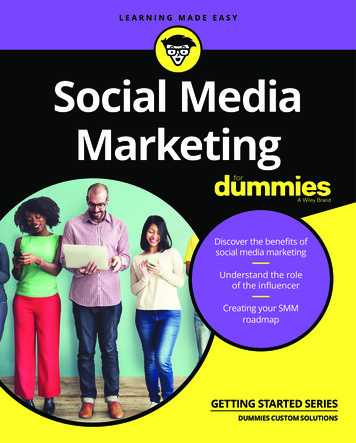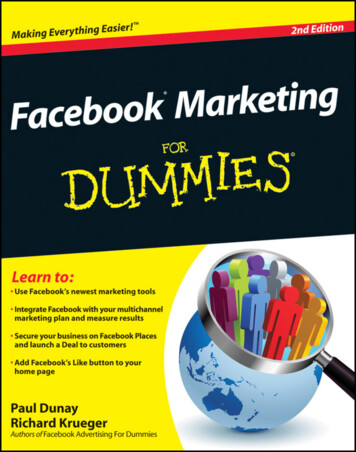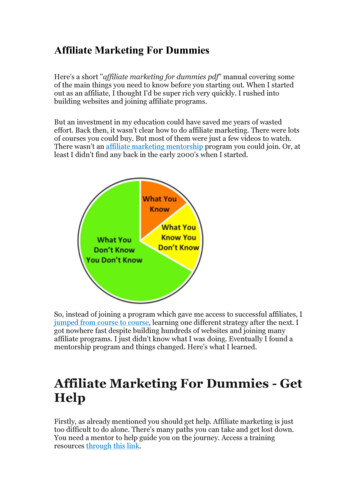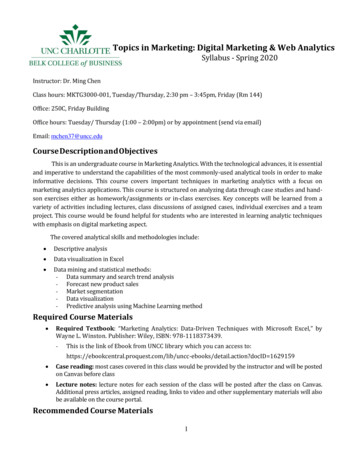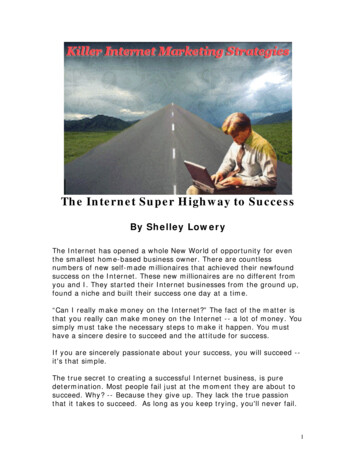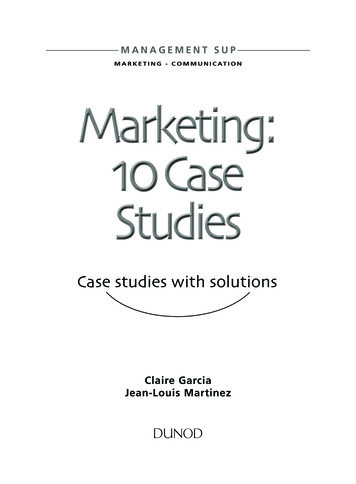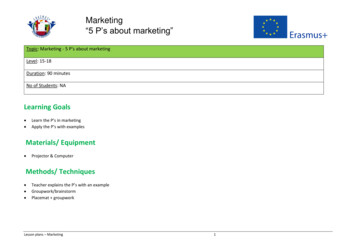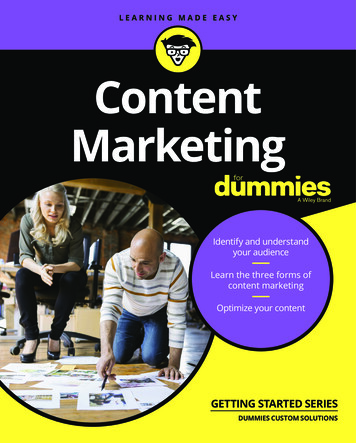
Transcription
ContentMarketingIdentify and understandyour audienceLearn the three forms ofcontent marketingOptimize your contentGETTING STARTED SERIESDUMMIES CUSTOM SOLUTIONS
IN THIS CHAPTER»» Understanding content marketing»» Discovering your audience»» Learning how to think like apublisher»» Establishing content marketinggoals»» Researching your competitionGetting Started inContent MarketingContent marketing encompasses all forms of content that add value to consumers, thereby directly or indirectly promoting a business, brand, products, or services. Content marketing occurs both online and offline, but thefree and simple tools of the social Web have opened up the ability for companiesof all sizes to compete alongside one another, not for market share but for voiceand influence.Marketing a business using content isn’t a new concept; however, it has evolvedin recent years to mean far more than creating a company brochure filled withovertly promotional messages and images. Today, content marketing focuses oncreating content that is meaningful and useful to consumers with promotion taking a backseat to adding value, particularly adding value to the online conversationhappening across the social Web.To achieve success, companies need to engage consumers rather than interruptthem. Consider a pop-up ad appearing on a website today. It wasn’t so long agothat pop-up ads were all the rage among marketers. Today, they’re a sure-fireway to annoy customers and cause them to turn away from your brand. Ratherthan taking control of consumers’ online experiences, businesses need to enhancethose experiences, and they can do it with content that adds value and engagesconsumers.
Defining the Three Forms ofContent MarketingContent marketing comes in three basic forms — long-form, short-form, andconversations. It’s important to understand that content marketing is still a relatively new form of marketing, and no one knows the recipe for success. Only afew rules and some loose guidelines are available for businesses and marketers tofollow. In fact, you’re really limited only by your creativity and dedication. Truthbe told, any content that you make publicly available online and offline could beconsidered a type of content marketing because all content is a reflection of yourbrand and business. Furthermore, all content opens up a potential talking point forconsumers to consider, dissect, analyze, and debate.The three forms of content marketing that you can create, publish, and share aspart of your content marketing plan follow:»» Long-form content marketing: Includes all published content that’s longerthan a few sentences and that offers deep value, such as blog posts, articles,ebooks, press releases, white papers, presentations, videos, podcasts, webinars, and so on.»» Short-form content marketing: Includes all published content with no morethan a few sentences and that communicates useful information, such associal updates, graphics, images, and so on.»» Conversations and sharing content marketing: Can happen throughconversations about published content and through the sharing of publishedcontent, such as blog comments, social updates, link sharing via social bookmarking, comments on videos and images, and so on.The important thing to remember is that you’re likely to see overlap between thethree forms as well as overlap with social media and traditional online marketingefforts. That’s a good thing! The best marketing plan is a fully integrated strategywhere one piece connects to the next.Identifying Your AudienceFinding your audience is a fundamental step in building a business. Once you determine the customers you want to target, you need to then define ways to find thosecustomers in order to provide them with meaningful advertising, promotions, andGetting Started in Content Marketing3
so on — or in the case of content marketing, more useful and shareworthy content.The traditional way of taking this step is to segment your customers by focusingon similar demographic characteristics, such as age, income level, gender, and soon, and then to find similar people based on those demographics.However, this approach is not necessarily the most effective way to segment andtarget customers in the world of the social Web. It’s true that you need to knowthe primary demographic profiles of your best customer audiences and whetherthose profiles match sites where your audience might spend time; however, thosefactors aren’t the only ones that matter — because the social Web can be analyzed using behaviors in addition to demographics. In fact, behavioral targeting isoften more powerful than demographic targeting because, while using the Internet for researching, communicating, shopping, building relationships, and more,people don’t necessarily reveal personal demographic information. Furthermore,the social Web is filled with people who participate in conversations and publishcontent anonymously or by using pseudonyms, so it can be very difficult to actually compile demographic information about these people.Clearly, relying on demographic segmentation when building a content marketing strategy may lead your business down a path to failure. Instead, Internet usersneed to be segmented and targeted based on their online behaviors. What sites dothey visit? What conversations do they join, and what do they say in those conversations? What content do they share with their own audiences? Those are justa few of the relevant questions marketers need to ask to understand their currentand potential online audiences.By continually evaluating customer behaviors and adjusting the marketing strategy to address those behaviors, marketers can help ensure they find the right customer and introduce the best content for that customer, in the right places, and atthe right time.The best content marketing strategies involve finding your audience and publishing the right kind of content to interest these people and add value to their lives.A combination of demographic and behavioral targeting is essential to creating asolid content marketing strategy.A good way to start identifying your customer and their needs is by building apersona or buyer’s profile. This type of exercise helps you narrow down your customer, identify their pain points, and decide what content you can create to bestmeet their needs. For instructions and a template to start building a persona, clickhere.Getting Started in Content Marketing4
Discovering what your audiencewants and needsIf you’re not delivering the type of content your target audience wants and needs,they won’t read or view your content nor will they share it. In fact, they might ignoreyou or publish negative responses to your content. You don’t want that to happen.Just as you need to determine what your audience wants and needs from yourproducts and services to develop effective advertising, you need to determine whatyour audience wants and needs from content.To find out what your audience wants and needs from your content, you can startby listening. In fact, listening is one of the most important parts of any successful content marketing strategy. You need to constantly be listening to the onlineconversation so that you can modify your content marketing strategy as necessary.Consumers move quickly and change their minds even more quickly. If they findyour content to be stale or outdated, they’ll move on in search of another businessor destination that offers the type of value-added information they want and need.Ask your customers both in person and online what kind of information they wantand need. Publish a poll on your blog using a tool like Polldaddy or SurveyMonkey,or pose the question on a forum or group you belong to where your target audiencespends time. Additionally, pay attention to your own website and blog analytics tosee what content is driving a lot of traffic, comments, and incoming links.Your focus should be on long-term growth and trends. There will always be a fewaudience members who are louder than others, and certain pieces of content mightattract a lot of attention. It’s up to you to find fluctuations that spell opportunities and weed out anomalies that won’t drive business in the long run. Pursue theopportunities aggressively, and put the anomalous traffic spikes on the backburner.Shifting from a Marketer toa Publisher MindsetOne of the first things you must do in order to be successful with content marketing is to forget everything you know about marketing. That’s a scary conceptfor many people. For years, businesses have been following marketing strategiesbased on interrupting consumers. For your content marketing efforts to work, youneed to put the aggressive marketing mindset on the backburner and focus onwriting and publishing shareworthy content.Getting Started in Content Marketing5
Therefore, as you’re creating content, do so with your audience in mind, not yourbusiness goals. Deliver the content your audience wants and needs and then promote that content separately through your social media interactions. Inevitably,your content and social media marketing activities will overlap, but your contentshould be able to stand on its own, separate from your social media marketingtactics.Applying the 80-20 ruleIn marketing theory, the 80-20 rule states that 80 percent of business comes from20 percent of the customers. I like to use a similar concept when it comes to content marketing and social media marketing. Remember, you have to think like apublisher to be successful with content marketing. If you apply the 80-20 rule toyour content marketing efforts, 80 percent or more of the content you developshould not be self-promotional and 20 percent or less should be self-promotional.That means the vast majority of the time you spend on content marketing activities won’t be directly related to marketing at all.But hold on! Just because 80 percent of your efforts aren’t directly self-promotional doesn’t mean they’re not indirectly marketing your business. In fact, it’sindirect marketing that makes content marketing so powerful. Every piece ofcontent you publish or share can add value to the online experience and furtherstrengthen your relationship with your online audience of brand advocates whowill talk about your content and share it with their own audiences. Don’t thinkcontent that doesn’t directly promote your business isn’t helping drive revenues.It just takes time to see the results. These interactions are happening indirectlyand often the effects are not immediately apparent.UNDERSTANDING CONTENT MARKETINGETIQUETTE AND AVOIDING TURN-OFFSAs a content marketer, you have to adhere to both written laws and the unwritten rulesof etiquette and acceptable behavior. If you break those unwritten rules, you coulddestroy all of your chances at achieving content marketing or social media marketingsuccess. To help you get started on the right foot, here are some of the most commoncontent marketing turn-offs and etiquette violations:Getting Started in Content Marketing6
Too much self-promotion: Stick to the 80-20 rule. If you spend too much time talkingabout yourself and self-promoting rather than engaging with other people, sharing theircontent, and adding value to the online conversation, people will start to ignore you orremove you from their radar screens entirely.Intentionally or accidentally spamming: Don’t participate in activities that can be labeledas spam. For example, don’t leave comments on blog posts that include nothing but linksback to your own site, and don’t publish blog posts that are nothing more than an ad ormarketing piece selling your products. Always try to add value and engage people, andyou should be safe.Not attributing sources: Don’t publish content without giving a virtual hat tip to thesource that gave you the story idea. For example, if you publish a blog post about a hottopic related to your business that you heard about from another blog or online source,link back to that source within your content. Doing so helps to build relationships andadds to your credibility.Not sounding human: Content marketing should avoid corporate rhetoric and shouldnever read like a corporate brochure. Instead, content marketing should sound morepersonable and closer in tone and style to social media marketing than formal communications. No one will want to connect with you and engage with you if you sound likeyou’re reading from a corporate document.Not acknowledging people: Part of content marketing includes engaging with the peoplewho read or view your content and respond to it. Don’t publish content and forget it. Youneed to be available to respond to comments, answer questions, and so on, or your content marketing efforts will die before they have a chance to drive any indirect or directresults to your business.Sending automated messages: People are busy, and automated messages clutterinboxes and annoy recipients. For example, don’t send an automated self-promotionalmessage to everyone who follows you on Twitter telling them to check out your website,blog, Facebook Page, and so on. That’s an easy way to make people regret following you.The more time you spend publishing content and engaging with other people, the moreyou’ll discover about your target audience. Always listen to what they have to say so thatyou can adjust your content marketing efforts to meet their wants and needs. They’reyour best source of information for current turn-offs and etiquette expectations. Payattention and apply what you find out! What is acceptable today may not be tomorrow.Getting Started in Content Marketing7
Adding value, staying relevant,and being shareworthyIf you’re following the 80-20 rule, you know that 80 percent of your contentshould add value to the online experience, particularly for your target audience.This is how you build relationships and set expectations for your target audienceand among online influencers who can help to spread your messages even fartheracross the global Web community. You need to take the time to research what typeof information, messages, and content your target audience wants from a businesslike yours, and then deliver that content in a professional manner.In addition, you need to offer content that your audience will share with others. Traditional publishers use this strategy to create content that not only sellsnewspapers or magazines but also offers a pass-along value that may convert secondary readers into subscribers. The same concept holds true for content marketing today. The difference is that today anyone, including you, can be a contentpublisher and use that content to lead to bigger and better things, such as brandawareness, business growth, and sales.Never has there been such an exciting opportunity for small and mid-size businesses to stake their claims and position themselves for success — because nowit’s not necessarily the depth of your wallet that leads to success through contentmarketing but rather the depth of your words. Content marketing enables businesses to continually meet customer expectations and to add something extra tothe consumer experience that helps develop trust, security, and loyalty.Content marketing offers the perfect way for businesses to leverage the three S’sof Customer Loyalty:»» Stability: Customers become loyal to a product, brand, or business when itsends a consistent message they can trust and rely on.»» Sustainability: Customers become loyal to a product, brand, or businesswhen they believe it will be with them for a long time or at least for a specificamount of time with a predetermined end.»» Security: Customers become loyal to a product, brand, or business when itgives them a feeling of comfort or peace of mind.As you can see, consumers actively look for products, brands, and businesses thatthey feel they can trust and that won’t abandon them. They become emotionallyinvolved in the products, brands, and businesses that help them feel a sense ofcomfort. A well-executed content marketing strategy can offer the stability, sustainability, and security that consumers seek, and it can help them develop anemotional connection and relationship with a product, brand, or business.Getting Started in Content Marketing8
Establishing Goals and Choosing theBest Forms of Content MarketingAs you develop your content marketing strategy, you need to do so with goals inmind. Since content marketing is very much a long-term marketing strategy,you must define where you want your business to be in the future. This strategy includes determining how much time you can devote to content marketing,the resources available to help you with your content marketing efforts, and theresults you want to attain from those efforts.However, you do need to approach content marketing realistically, or you won’tbe satisfied with your results. Remember, content marketing success comes in theform of long-term sustainable growth through brand building and relationshipdevelopment, which lead to loyalty and word-of-mouth marketing. You can supplement your long-term strategy with short-term tactics such as discount promotions, contests, and so on, but the power of content marketing comes from theorganic growth it creates.With that in mind, you need to move forward with a highly focused content marketing plan. You can’t be all things to all people. In fact, trying to spread yourself too thin will reduce your own content quality and confuse consumers. If youcan’t meet their expectations through your content, they’ll leave you behind andfind someone who can. The most powerful brands are highly focused brands withaccessible content, so it makes sense that with all the clutter and competition fora share of voice online that optimized, niche-focused content can help you stakeyour claim in the online space. Your brand, online reputation, and business willbenefit immensely if you take the time to choose a specific area of focus and optimize your content to ensure it can be found easily.You also need to think about the types of content marketing you can realisticallypursue given the amount of time and technical savvy they require. You’ll want toconsider the types of content your audience will best respond to as well, to ensureyou make smart content choices that are an efficient and effective use of the timeand resources available.The best part about content marketing is that the tools of the social Web thatenable you to publish content are fairly easy to use. If you can use word-processingsoftware and an Internet browser, then you can use social Web tools.Take some time to create accounts on the most popular sites that enable you topublish content such as WordPress.org for a blog, Facebook.com for social networking, and Twitter.com for microblogging. To choose which accounts are rightfor your business, first identify which tools you have the bandwidth to manageGetting Started in Content Marketing9
DON’T FORGET THE KEYWORDSBefore you begin creating and publishing content, take some time to identify what keywords and keyword phrases you need to focus on to optimize your content for yourtarget audience. Drill down and find the specific keyword phrases that will drive trafficto your content — and that will help you avoid competing with larger organizations thathave bigger budgets to spend on search engine optimization.Following are several free and paid tools that can help you determine which keywordphrases to target in your content:Google AdWords Keyword Planner: The free tool enables you to find out the popularityof keywords and see how certain ones might perform.Wordtracker: To use Wordtracker, you have to pay a fee, but a free trial is available. Ifyou’re serious about keyword research, then Wordtracker is a good tool with a fairly reasonable price tag.Keyword Discovery: Keyword Discovery is another tool for keyword research, but it alsohas a fee associated with it. A free trial is available, so you can give it a test drive beforeyou pay anything. The results you’ll get from Keyword Discovery are extensive and bestfor someone who really wants to drill down deep into keyword research.BrightEdge: Although this is a pricey option, it provides a lot of great tools to help youachieve your content goals in addition to keyword optimization. One additional benefit isthat it has enterprise options.Search engine optimization is important, but don’t let it take center stage. Your contentis always the top priority. Make sure what you say is the cornerstone of your contentmarketing efforts. For the best chance of getting people to engage with and share yourcontent, you need to be genuine and make sure the content you create is always meaningful, relevant, and useful to your customers.effectively, where your target audience is most engaged, and what sites will bevaluable for the long-term, and begin to define your marketing strategies usingthose tools as your top branded online destinations. Before you announce thatyou’re joining the social Web or start reaching out to other people online, playaround with the features and start publishing content to build up an archive ofamazing content.Getting Started in Content Marketing10
Next, it’s time to develop goals. Your content marketing goals need to be realistic and measurable. For example, you might create a goal to develop three viablebranded online destinations within the next three months, or you might createa goal to attract 1,000 quality Twitter followers over the next six months. Theseare both good goals, but make sure that you also identify what you will measureto prove if these strategies are effective, for instance what determines a viabledestination or a quality follower. This could include traffic metrics that show theviability of a site or interactions details that prove the quality of a follower.Make sure your content marketing goals are always based on quality, not quantitybecause if you publish quality content and focus on developing quality audiences,quantity will come organically in time. In other words, your content marketingstrategy is successful when the compounding effect begins to truly work for youand you see your numbers growing simply because your content and conversationsare meeting customer expectations.Quality content and relationships help you increase your sphere of influence in theonline space, which is a valuable intangible business asset.Knowing Your CompetitionYou’ll find it very difficult to achieve higher levels of business success if you don’tknow what your competitors are doing. In order to develop your content marketing strategy, you need to know your competition as well as you know yourself.Researching your competition allows you to react appropriately to their contentmarketing tactics and even to anticipate some of those potential tactics. In otherwords, by knowing your competition, you can more effectively position your business in the minds of consumers and meet their needs and expectations. More specifically, competitive research enables you to find and exploit your competitors’weaknesses, position your brand as a brand of choice, establish your unique niche,and differentiate your business from other businesses.Don’t be tempted to assume that you already know everything about your competitors from years of experience. The social Web is a completely different space, andwhat worked offline through traditional marketing strategies and tactics is unlikelyto work as effectively online. Consumers are actively looking for information. Giveit to them, and know what your competition is doing so you can give consumers theinformation they’re actively seeking better than your competition does.Getting Started in Content Marketing11
Finding your competition online andmonitoring their activitiesThe first step to researching your competitors is finding them across the socialWeb. However, you need to analyze more than your competitors’ websites. Fortunately, a variety of tools are available to help you find your competition online.When you find your competitors, you need to analyze what they’re doing on theirbranded online destinations as well as on sites they don’t own but simply maintaina presence on.Following are a number of methods and tools you can use to conduct yourcompetitive online research:»» Google Alerts: Set up Google Alerts to send you alerts for your competitors’names.»» Social Media: Follow your competitor’s social media accounts, where you canreceive their tweets and updates.»» LinkedIn: Follow your competitors’ profiles on LinkedIn and read theirupdates. If you know the names of your competitors’ executives or employees, you can search for them on LinkedIn using the search tool. Note that youcan’t view a private profile unless you’re connected with that person.»» On-site searches: Visit your competitors’ websites and blogs and lookfor links to other online profiles or branded destinations such as YouTubechannels, Flickr profiles, and so on. Companies that are implementing a socialmedia marketing or content marketing plan should have links to their variousbranded online destinations prominently displayed on their websites andblogs.As you find your competitors’ online destinations and conversations, analyzethem to discover what kind of content your competitors are publishing. Can youfind any gaps or any opportunities to “borrow” a share of voice or to offer contentthat your target audience isn’t already getting from your competitors? Is there away to repackage the type of information they’re publishing to make it more useful and interesting to consumers? What content are your competitors publishingthat sparks conversations or sharing? Your findings can help you determine whatkind of content to create and where to publish it.Getting Started in Content Marketing12
Finding gaps and opportunitiesAs you monitor ongoing conversations within your target audience, as well as yourcompetitors’ involvement in those conversations and related content, look foropportunities to fill gaps and offer something different or offer similar information in a better way. In other words, don’t market scared. Just because your competitors are publishing a specific type of content in a specific way doesn’t meanthose strategies or tactics are right for you and your audience. However, knowingwhat those strategies and tactics are can help you differentiate your business orbetter position your brand as the brand of choice.Just as each piece of content that you publish becomes part of the larger compounding effect that can deliver long-term sustainable growth to your business,so do your research and analysis efforts. Altogether, your activities will enable youto drive organic buzz about your business that can be far more powerful than asimple banner ad.Try to think out-of-the-box and come up with new ways to offer content thatyour audience wants and needs. For example, if you sell customized gift basketsonline, allow consumers to view those baskets through online video so that theycan see exactly what their money will buy and make changes on demand. Thisvisual approach provides a creative way to add a tangible element to an online buying process. A business that once could thrive only offline can now thrive online,thanks to creative content marketing and communications via the user-generatedcontent of the social Web.If you own a business that can help customers by offering step-by-step tutorials,don’t just provide in-person training classes or instruction manuals. Instead, adda content marketing aspect by offering webinars or screencast tutorials. You caneven turn tutorials into videos that can be shared across the social Web to broadenthe reach of your content and indirectly market your business.By offering useful information to consumers, you build a relationship with thembased on appreciation and trust. In this way, you can deliver positive word-ofmouth marketing as well as tangible results to your business for years to come.To get more tips on how you can expand your marketing efforts, visit dummies.com/custom-solutions and check out our Getting Started marketing series. Thisseries includes ebooks highlighting the basics behind several popular marketingmethods and a guide to help you bring these tactics together into an integratedmarketing campaign.Getting Started in Content Marketing13
We Make Your Job EasierFrom ebooks and infographics to videos and sponsorships, dummies B2Bmakes it easier for you to connect with your customers. We help you buildassets that engage, inspire, and drive sales, so that you can spend less timemanaging content creation and more time focused on your customers.See how dummies B2B can help you.Visit dummies.com/custom-solutions today!
Content marketing comes in three basic forms — long-form, short-form, and conversations. It’s important to understand that content marketing is still a rela - tively new form of marketing, and no one knows the recipe for success. Only a few rules and some loose guideli
